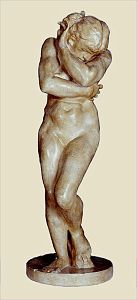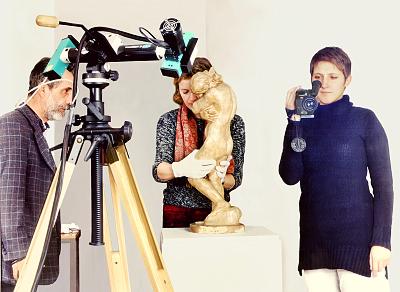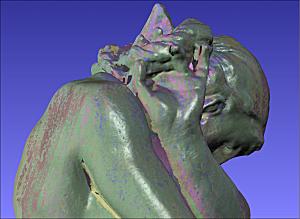 
Survey of Eve Medium size plaster in Heilbronn (1)
|

Eva, painted plaster,
Sculpture Museum Heilbronn.
All photos/graphics: H. de Roos
|
In February 2003 our team paid a new visit to the Breuckmann facilities in
Meersburg, to win a deeper knowledge of the HE sensors and the newest
version of Optocat Software. Subsequently, we visited the Sculpture Museum in
the inner city of Heilbronn, together with Dr Breuckmann as the manufacturer of
the equipment. This Museum displays a medium-sized Eve plaster.
According to the Museum´s catalogue, the object is 72 cm high; it would be a
bozzetto, which means a sketch or design version. The plaster is on loan
from the Ministery of Science and Art of the Baden-Württemberg County and was
purchased in 1997 from the Swiss Gallery Beyeler, with financial support of the
Ernst Vogelmann Foundation. Supposedly, the plaster comes from the Alexis Rudier
Foundry and was part of the private collection of the Paris architect Jean-Claude
Dondel, who
deceased in 1989. The Beyeler gallery had acquired the plaster on a Christie's
auction in New York, on 3 Nov. 1993.
On Monday, 10 February 2003, we were able to do the survey on our own.
During the morning, we worked with the larger sensor (600 mm diagonal field of
view), during the afternoon with the smaller, high-resolution 200 mm sensor.
|
|
Altogether, we produced 62 scans, which were matched
still in the Museum with the newly improved Optocat-Software. Here too,
every scan contained 1.3 Million spatial co-ordinates. By ICP contour
matching, every single point is considered as a set of 3D co-ordinates
plus a vector expressing the local direction of the surface. All points
are compared to other points in the immediate neighbourhood, to find
similar surface patterns. On this basis, the patches are matched
together. |

The Eve plaster is moved with caution by Curator Annette
Ludwig, so that we can survey the backside as well.
|
|

Screenshot of the patches matched with Optocat Software.
|
To speed up our workflow, the virtual model was simplified for display, with
a resolution of 1 line/mm. Still, time became very short, due to the complex
structure of the figure and the many occlusions. Finally, we had to conclude
that digitizing this small statue was nearly as as complicated as surveying the large
Thinker plaster in Strasbourg.
Simultaneously, we produced series of stereographical photographs, that were
post-processed in Munich and matched as anaglyph stereo pairs.
|
|